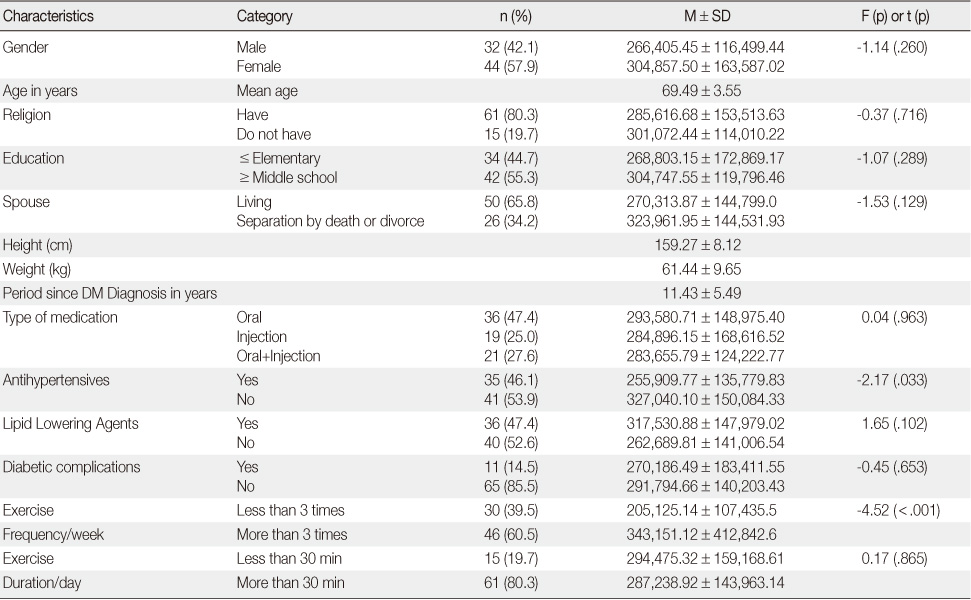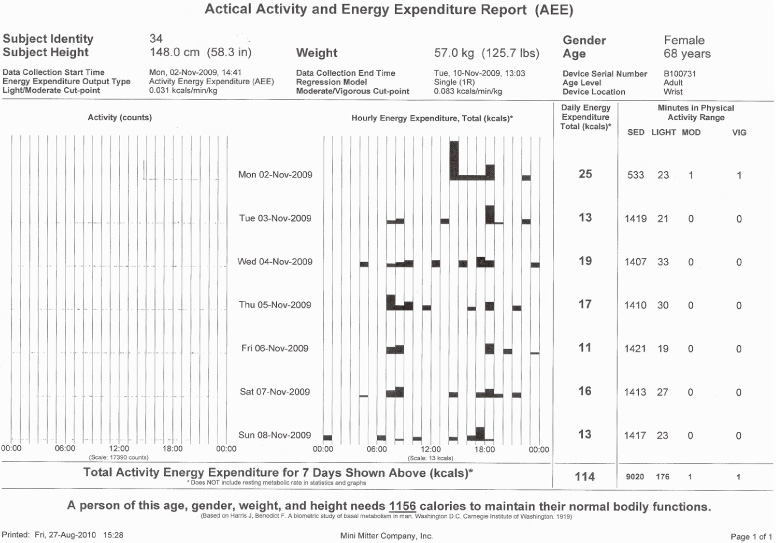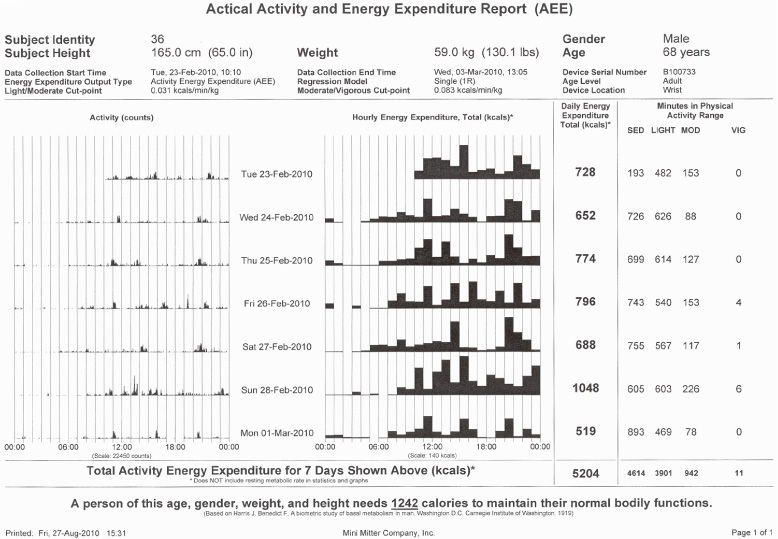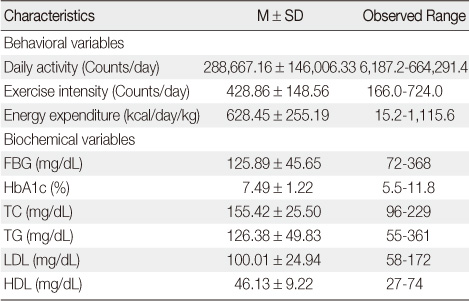Articles
- Page Path
- HOME > J Korean Acad Nurs > Volume 41(2); 2011 > Article
-
Original Article
- Relationship of Daily Activity and Biochemical Variables in the Elderly with Diabetes Mellitus
- Ki-Wol Sung
-
Journal of Korean Academy of Nursing 2011;41(2):182-190.
DOI: https://doi.org/10.4040/jkan.2011.41.2.182
Published online: April 30, 2011
Associate Professor, Department of Nursing, Catholic University of Daegu, Daegu, Korea.
- Address reprint requests to: Sung, Ki-Wol. College of Nursing, Catholic University of Daegu, 3056-6 Daemyeong 4-dong, Nam-gu, Daegu 705-718, Korea. Tel: +82-53-650-4826, Cell: +82-10-7235-6342, Fax: +82-53-650-4392, kwseng@cu.ac.kr
© 2011 Korean Society of Nursing Science
Abstract
-
Purpose
- This study was done to identify correlates and variables predicting daily activity among elders with Diabetes Mellitus (DM).
-
Methods
- Seventy-six elders registered in the Department of Endocrine Medicine at C university hospital participated in data collection. Data on daily activity and biochemical variables were collected via actigraph accelerator (Actical) and blood tests between September 2009 and July 2010. Data analysis was done using SPSS WIN 15.0 program and included one-way ANOVA, independent t-test, Pearson correlation coefficients, and stepwise multiple regression.
-
Results
- This study showed a positive correlation between daily activity and High Density Lipoprotein Cholesterol (HDL-C) and a negative correlation among Total Cholesterol (TC), Triglyceride (TG), and Low Density Lipoprotein Cholesterol (LDL-C). The variables predicting daily activity were frequency of exercise, HDL-C, and TC. These factors accounted for 40.0% of the variance of daily activity in elders with DM.
-
Conclusion
- The results indicate that it is necessary to improve daily activity to reduce Fasting Blood Glucose (FBG), TC, and TG in elders with DM.
- 1. American College of Sports Medicine. ACSM's guidelines for exercise testing and prescription. 2007;7th. London, Lippincott Williams & Wilkins.
- 2. Bae JH. The effects of sports social factors on continuous physical activity and resocialization in old woman. Journal of Korea Sport Research. 2004;15:869–880.
- 3. Ballard JE, McFarland C, Wallace LS, Holiday DB, Roberson G. The effects of 15 weeks of exercise on balance, leg strength, and reduction in falls in 40 women aged 65 to 89 years. Journal of the American Medical Women's Association. 2004;59:255–261.
- 4. Browning C, Sims J, Kendig H, Teshuva K. Predictors of physical activity behavior in older community-dwelling adults. Journal of Allied Health. 2009;38:8–17.PubMed
- 5. Davis JN, Hodges VA, Gillham MB. Physical activity compliance: Differences between overweight/obese and normal-weight adults. Obesity (Silver Spring). 2006;14:2259–2265.ArticlePubMed
- 6. Davis MG, Fox KR. Physical activity patterns assessed by accelerometry in older people. European Journal of Applied Physiology. 2006;100:581–589.ArticlePubMedPDF
- 7. Faul F, Erdfelder E, Buchner A, Lang AG. Statistical power analyses using G*Power 3.1: Tests for correlation and regression analyses. Behavior Research Methods. 2009;41:1149–1160.ArticlePubMedPDF
- 8. Han DW, Cho MS, Kim YG. The effects of self-phased walking exercises on elderly women with hypertension, hyperglycemia, and hypercholesterolemia. Journal of the Korean Academy of University Trained Physical Therapists. 2008;15(1):54–60.
- 9. Han IS, Son WI. Effects of aerobic walking training on serum lipids and lipoprotein in older females. Journal of Korea Sport Research. 2004;15:1683–1696.
- 10. Hendelman D, Miller K, Baggett C, Debold E, Freedson P. Validity of accelerometry for the assessment of moderate intensity physical activity in the field. Medicine and Science in Sports and Exercise. 2000;32:S442–S449.ArticlePubMed
- 11. Kim HS, Chung CK, Lee KS. The effect of strengthening exercise program on the physical activity, activities of daily living, social behavior and functional performance of the elderly on a home for the aged. Korean Journal of Preventive Medicine. 2002;35:107–115.
- 12. Kim KB. The effects of physical activity on mood states and health related physical fitness in older adults. Journal of Korea Sport Research. 2006;17:223–232.
- 13. Kim SH, Lee HS, Kang JH, Park HA, Kim MJ, Kim YH, et al. Relationship between physical activity, dietary habits and overweight of 7-year-old Korean children. Journal of the Korean Academy of Family Medicine. 2007;28:195–203.
- 14. Kim YS, Kong SA, Lee O, Kim JW, Kim SS, Park IH. The relation between physical activity and fitness in children. Exercise Science. 2008;17:495–504.Article
- 15. Kwon SB, Kim KH, Kim BS, Park HJ. Health related behaviors and activities of daily living of elders aged 65 or over in an urban area. Journal of the Korean Public Health Association. 1994;20(2):3–22.
- 16. Lee HR, Yu JM, Choi MG, Yoo HJ, Hong EG. Risk factors for early development of macrovascular complication in Korea type 2 diabetes. Korean Diabetes Journal. 2009;33:134–142.
- 17. Livingstone MB, Robson PJ, Wallace JM, McKinley MC. How active are we? Levels of routine physical activity in children and adults. The Proceedings of the Nutrition Society. 2003;62:681–701.ArticlePubMed
- 18. Ministry for Health, Welfare and Family Affairs. 4th Korean national health and nutrition examination survey. 2008;Seoul, Author.
- 19. Nelson E, Rejeski W, Blair N, Duncan W, Judge O, King C, et al. Physical activity and public health in older adults recommendation from the American college of sports medicine and the American heart association. Medicine and Science in Sports and Exercise. 2007;39:1435–1445.PubMed
- 20. Park M, Kim BR, Kang SJ, Lee DK. Effects of regular exercise on health-related fitness, cardiovascular disease risk factor and vascular inflammation factors in the male. Health & Sports Medicine. 2007;9(1):69–76.
- 21. Park SH, Yoo HS, Kim KH, An GY, Huh Y, Chang JY. A model for promoting exercise adherence. Journal of Korea Sport Research. 2005;16(6):197–204.
- 22. Park S, Park YH. Predictors of physical activity in Korean older adults: Distinction between urban and rural areas. Journal of Korean Academy of Nursing. 2010;40:191–201.ArticlePubMed
- 23. Ramsbottom R, Ambler A, Potter J, Jordan B, Nevill A, Williams C. The effect of 6 months training on leg power, balance, and functional mobility of independently living adults over 70 years old. Journal of Aging and Physical Activity. 2004;12:497–510.ArticlePubMed
- 24. Sakuragi S, Sugiyama Y. Effects of daily walking on subjective symptoms, mood and autonomic nervous function. Journal of physiological anthropology. 2006;25:281–289.ArticlePubMed
- 25. Sallis JF, Saelens BE. Assessment of physical activity by self-report; Status, limitations, and future directions. Research Quarterly for Exercise and Sport. 2000;71:S1–S14.PubMed
- 26. Trost SG. Objective measurement of physical activity in youth: Current issues, future directions. Exercise and Sport Sciences Reviews. 2001;29(1):32–36.ArticlePubMed
- 27. Twisk JW, Kemper HC, van Mechelen W. Tracking of activity and fitness and the relationship with cardiovascular disease risk factors. Medicine & Science in Sports & Exercise. 2000;32:1455–1461.Article
- 28. Yoo KA. The effect of treadmill walking exercise on obesity, diabetes and hyperlipidemia. 2007;Yongin, Yongin University. Unpublished master's thesis.
- 29. Yu HJ. In : Hu GB. Elderly diabetes mellitus. In: Diabetes mellitus in geriatric population. 2006;07;In: Symposium conducted at the 3rd Annual Congress of Korean Diabetes Association; Seoul.
REFERENCES

Figure & Data
REFERENCES
Citations

- Goal Attainment Rate for Parameters of Metabolic Adjustment in Elderly Patients with Type 2 Diabetes Taking a Hypoglycemic Agent
Kang Hee Shim, Moon Sook Hwang, Jeong Eun Park, Jin Hee Jung, Jung Hwa Lee, Bok Rye Song
The Journal of Korean Diabetes.2018; 19(1): 58. CrossRef - Factors Influencing Physical Activity among Community-dwelling Older Adults with Type 2 Diabetes: A Path Analysis
Sun Joo Jang, Hyunju Park, Hyunjung Kim, Sun Ju Chang
Journal of Korean Academy of Nursing.2015; 45(3): 329. CrossRef - Analysis of Physical Activity Measured by International Physical Activity Questionnaire and Actigraph Accelerometer, and Participation Intention for Physical Activity of Breast Cancer Survivors
Jee Yeon Park, Nahyun Kim, Sun Hee Kang
Journal of Korean Biological Nursing Science.2015; 17(2): 104. CrossRef - A Study on Physical Activity and Related Factors to Physical Activity for the Elderly with Diabetes Mellitus
Hye-Yeon Kang, Mee-Ock Gu
Journal of muscle and joint health.2012; 19(1): 57. CrossRef


Figure 1
Figure 2
Differences in Daily Activity according to General Characteristics & Health Condition of Elders with DM (N=76)
Description of Behavioral and Biochemical Variables in Elders with DM (N=76)
FBG=fasting blood glucose; TC=total cholesterol; TG=triglycerides; LDL-C=low density lipoprotein cholesterol; HDL-C=high density lipoprotein cholesterol.
Correlations of Daily Activity for Behavioral and Biochemical Variables in Elders with DM (N=76)
FBG=fasting blood glucose; TC=total cholesterol; TG=triglycerides; LDL-C=low density lipoprotein cholesterol; HDL-C=high density lipoprotein cholesterol.
Variables Predicting Daily Activity in Elders with DM (N=76)
FBG=fasting blood glucose; TC=total cholesterol; TG=triglycerides; LDL-C=low density lipoprotein cholesterol; HDL-C=high density lipoprotein cholesterol.
FBG=fasting blood glucose; TC=total cholesterol; TG=triglycerides; LDL-C=low density lipoprotein cholesterol; HDL-C=high density lipoprotein cholesterol.
 KSNS
KSNS
 E-SUBMISSION
E-SUBMISSION





 Cite
Cite

